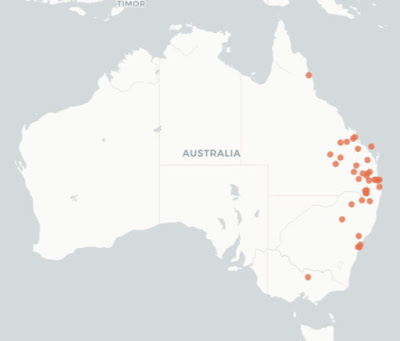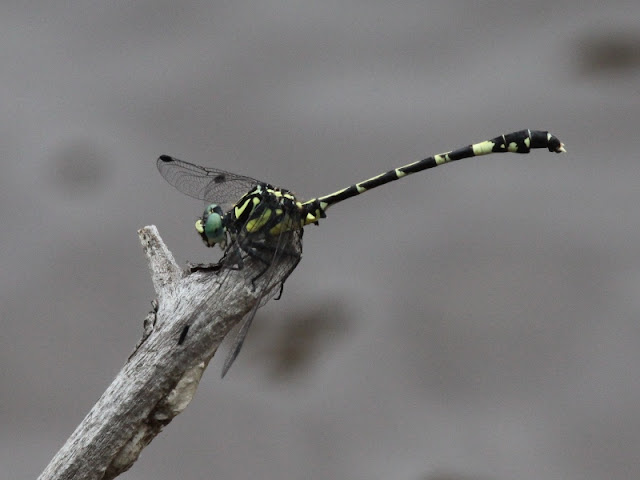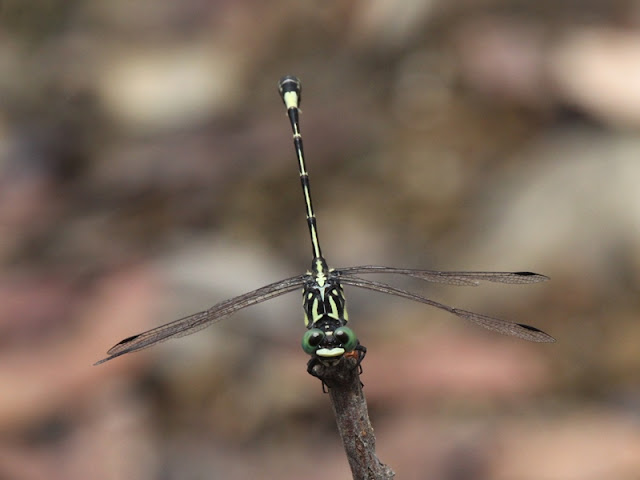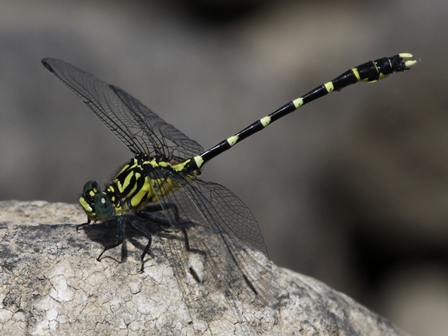It was Saturday afternoon and 40 degrees outside. I was in
the relative comfort of the study, the fan blowing a cooling breeze, when a
report came through on the online Canberra
Nature Map (CNM) of a Unicorn Hunter – a type of dragonfly that, in the
ACT, frequents sand or shingle beds along some of the lower altitude rivers. As
a moderator for dragonflies on the CNM platform I logged in and had a look at
the photo. An initial cursory glance showed a tell-tale yellow double band at the 7th abdominal segment, then I looked at the antehumeral stripe to ensure it was ‘attached’ to the
collar – it was; but something about the spots on the side of the final
abdominal segments, and the pattern of the yellow patches on the side
of the thorax, just didn’t seem quite right. Then I looked at the location of
the sighting. It was all wrong. It was from open woodland, though not too far
from a few small ‘farm’ dams. But nothing like the sandy-edged river locations
preferred by Unicorn Hunters.
 |
| The photograph submitted to Canberra Nature Map, initially suggested to be a Unicorn Hunter. |
So I took a closer look at the thoracic and abdominal
patterns against the various other ‘hunters’ in the Theischinger & Hawking field guide, and it
became very apparent that the photo was in fact of a thing called Austroepigomphus praeruptus or Austroepigomphus melaleucae, the
Twin-spot Hunter.
This species pair has a bit of a confused
history. The original A. praeruptus
was described by Selys, in 1858, based on a single specimen from South
Australia; but the specimen was lost and has never been relocated. Meanwhile,
in 1909, Tillyard described a very similar species from Queensland and called
it A. melaleucae. Although the vast
majority of known records are from Queensland and northern NSW, it seems that
the species has now been accepted as A.
praeruptus and A. melaleucae has
been relegated to junior synonym status.
There are close to a hundred records of the species in the
Atlas of Living Australia (ALA), generally from inland south-eastern Queensland
and inland north-eastern NSW, but with some more coastal records, including as
far north as Cairns and as far south as Sydney. Interestingly, there is a 1976 record from Elanora Heights in the bushland of northern Sydney, less than a
kilometre from where I grew up and where I was a teenager at the time! There is also a tight cluster of three records
by Reiner Richter, from January/February 2016, from a small drying creek
between Shepparton and Euroa in northern Victoria.
 |
| Distibution of the 92 Atlas of Living Australia records (Jan 2019). |
In a personal email, Reiner indicated to me that a record,
in iNaturalist, is of, finally, a recent record of the species from South
Australia. This was of an individual in a very poor state from the Adelaide
hills.
So the finding of an individual of this species in the ACT
is an important and, for me personally, very exciting outcome, and fills a
sizable gap in the species’ distribution. I got onto John Bundock (the
naturalist photographer ‘colleague’ of mine who found the dragonfly and
submitted the record) immediately by phone, quizzing him on details such as was
it just the one individual, how far was it from the nearest water, did it hang
about, did he have any other photos of it etc, etc. It seemed to take a while,
but I eventually convinced him of the significance and excitement of his find
and we agreed to go out together in the morning to try to gather further
evidence.
Next day, Sunday 27 January 2019, dawned quite overcast and
we were even subjected to the occasional brief shower as we searched the first
dam. Not the greatest dragonfly hunting weather. It remained cloudy for several
hours but eventually gave way to more extended sunny periods and reached a
temperature of 30 degrees. We searched the woodland where John had seen the
dragonfly, now three days prior; we searched another couple of nearby small
dams, all of which had relatively low water levels. Blue Skimmers and Common
Bluetails were particularly evident, and we also recorded a few Red & Blue
Damsels and a single Blue Ringtail, but we found no evidence of any Twin-spot
Hunters.
We decided to head deeper into the woodland reserve to a
couple of other small dams that I’d been wanting to survey for a while, and as
we went, photographing any other insect life that caught our attention, my mind
started to formulate a possible scenario. If this species is known to inhabit
“sluggish streams and rivers, including isolated riverine pools”, it may well be likely that the
species has adapted to a nomadic lifestyle. This might go some way to
explaining its very patchy distribution through eastern and south-eastern
Australia, and the individual John had seen may well have been an itinerant or
wind-blown ‘traveller’. Fine as a theory, but not great for my personal
aspirations of seeing the species which I desperately wanted to do.
At the other dams there were lots more of what we’d already
seen and we added Tau Emeralds, an Inland Hunter and Wandering Percher. But
still no twin-spots. So finally, defeated by lack of success and the heat, we
decided to head back towards the car. We did a bit of a loop past another
drying dam before rejoining the main track just above one of the dams we’d
checked earlier that morning. As we approached, I noticed a Royal Tigertail
perched on a small emergent branch just out from the bank. We hadn’t seen this
species earlier, so I raised my camera and, even through the viewfinder, I
realised fairly quickly that this was no Royal Tigertail. I mentally checked
off abdominal banding and spots and thoracic markings and knew straight off
this was in fact a Twin-spot Hunter. Yes! We spent about half an hour scanning
the dam and taking hundreds of photos, eventually seeing three of the
twin-spots together.



When we dropped down to the next dam, the one we first
surveyed in dull showery conditions, we tallied no less than eight individual
Twin-spot Hunters, all along one edge of the dam, perching mainly on logs and
emergent submerged branches, but also occasionally on the stems of rushes or on
the gravelly bank. What a difference a bit of sunshine can make.
This completely changed things. These were not blow-ins, but
in all likelihood had emerged locally. The species was a ‘resident’, at least
for one season, of the ACT.
Now we need to monitor over the remainder of this season, and more importantly, check other potential sites in the region, and see if they show up again next season.











































